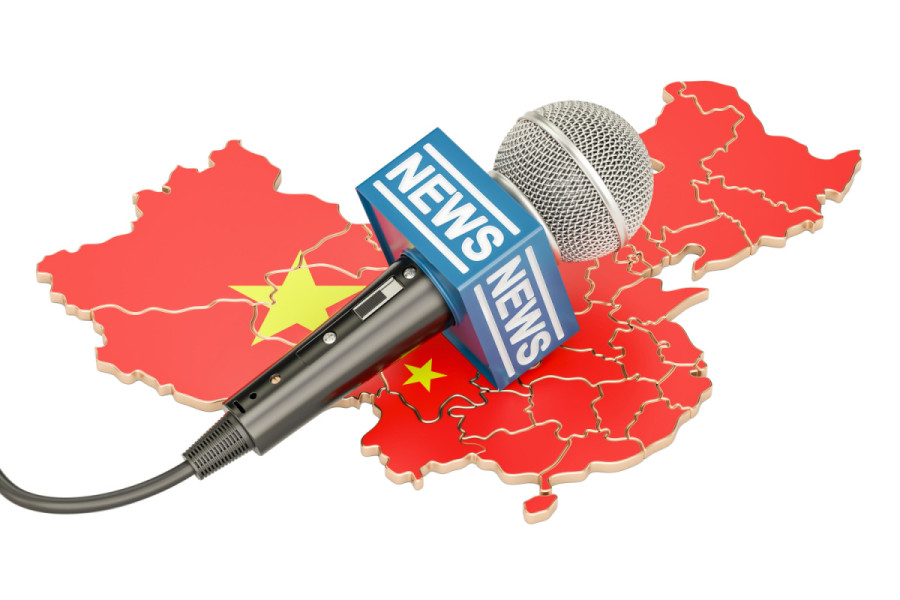Columns
Storytellers from up north
Chinese journalists find Nepal adaptable and familiar in terms of family and community values.
Dharma Adhikari
The Nepali, as well as the Chinese media, are often criticised for relying heavily on Western or even Indian media to interpret events in one another’s countries. Both countries now have a sizeable English-language press that is easily accessible online, but they fail to look at each other through their own media.
With its own state-controlled transnational media institutions like Xinhua, China Radio International (CRI) and CGTN, China is counteracting perceptions of the “China threat” and voicing its benign messages as a responsible power. A core part of a communicative function in public diplomacy also finds resonance in the Chinese campaign of “telling well the China story” (shuo hao zhongguo gushi) to a global audience. And increasingly, Chinese foreign correspondents are emerging as key players in their country’s public diplomacy efforts.
Based on my in-depth interviews with all six Chinese correspondents in Nepal, I share some insights into their journalistic worldviews and practices as a way to reflect on Nepal’s own engagement with the Chinese media.
Role orientations
The first official Chinese correspondent arrived in Nepal when Xinhua established its bureau in Kathmandu in 1960. Today, there are six correspondents working for Xinhua, CRI, China News Service (CNS), Wenhui Bao (Shanghai United Media Group) and Asia Pacific Daily. Wenhui opened its only South Asian bureau in Kathmandu in 1985. CNS also has the only bureau in Kathmandu covering the subcontinent. All except one are men.
Most are mid-career journalists, with an average of 7.5 years in Nepal. The motivations of Chinese correspondents are underpinned by duty orientations, national mission and journalistic career. They profess mixed role orientations, from a disseminator/storyteller to an advocate/diplomat role. Journalistic standardisation is more emphasised than the publicist role.
They find Nepal moderately newsworthy. Nepal appears next to Pakistan, India, Afghanistan and Sri Lanka in the news agenda. The general absence of news about Nepal in Chinese media is seen as a cause of celebration, as one correspondent noted: "No major issue means no 'bad news'.” Chinese correspondents, though, identified tourism, cultures/festivals (including stories on the Living Goddess) and heritage as the most dominant story for Chinese media, followed by Belt and Road Inititive/ bilateral trade, investment, infrastructure projects and Chinese companies in Nepal.
The fact that Nepal has a communist-led government also offers an ethnocentric dimension for Chinese media. Nature and unique geography (epitomised by Mt Chomolungma) are other major stories of interest. Disasters like earthquakes, air crashes and landslides are covered frequently. The India factor (including incidents of Indian encroachments or blockades) and Tibetan refugee issues also figure in the news agenda, as and when these incidents occur. Buddhism and Lumbini are newsworthy, but they are not covered as often and with the same zeal demonstrated by Nepalis, mainly because, as one correspondent put it, most Chinese audiences do not find any affinity with the religion.
The correspondents were asked to identify news that was newsworthy but hardly covered or not covered at all by the Chinese media. They gestured toward these varied topics: Nepal as a battleground for foreign powers; political controversies; endemic corruption; difficulties faced by Chinese investors and businesses in Nepal; political bickering in the government; persisting superstitions; lack of progress in development; and negative stories about Chinese (such as some Chinese citizens’ involvement in crimes in Nepal). Chinese correspondents said they avoided anything negative or controversial, for their focus was on amity and good neighbourly relations. One correspondent said a story on the “kidney racket” in Nepal that he dispatched was killed by his editor because, he was told, it reflected poorly on Nepal’s image.
Some of the most popular news stories from Nepal in Chinese media involves domesticating the news angle. In 2019, a Chinese correspondent wrote a 200-word piece about the then Chinese ambassador Hou Yanqi’s efforts to promote Nepal’s tourism via a photo shoot at a heritage site in Kathmandu. The story, released a few weeks before the Chinese New Year, earned more than 2 million reads back home.
Routines and context
Most Chinese journalists find Nepal adaptable and familiar in terms of family and community values as well as food culture. Access to human sources is generally easy for them. It is mediated sometimes by the embassy in interviews with the top leadership, including the prime minister and the President. However, some find access to official releases and invitations unsatisfactory. They call for a centralised distribution of authentic information, and more frequent invitations to news events. Chinese journalists find people easy to communicate with. In rural areas, language remains a barrier. Some use translation apps while others rely on local stringers to help as interpreters.
There are constraints. Most lamented that their press cards had to be renewed every four months. Certain areas (like Mustang) are off limits to individual foreigners, including journalists, thus impacting travel and reporting. National park entry fees of $1,000 are a turn-off. In terms of living conditions, some cited water shortages, poor utilities and pollution as the main concerns.
Chinese journalists also work under editorial pressures: Stories can be rejected or killed for lack of a positive spin. Editors demand brief stories on Nepal. Some journalists emphasised the need for self-reflection to break stereotypes. For instance, the Tarai region in the south remains relatively out of the way for Chinese journalists. “This kind of image should not appear in our mind,” said one correspondent. “We should go there, meet people and talk to them to dig into more truths for interesting stories.”
Others see the need for Chinese correspondents to address constraints in their countries’ media outreach in Nepal. In the view of a Chinese correspondent, Nepal’s English-language press hardly carries stories from the Xinhua wire service, and the AP or AFP stories they carry essentially propagate Western ideologies, projecting a distorted picture of China to the public. Of the 60 or so subscribers to Xinhua, most are vernacular and online outlets.
Several interviewees pointed out the need for a means to socialise with professionals. Some suggested that the government or the journalistic fraternity should help establish something like a foreign correspondents’ club or some such forum so all foreign correspondents in Nepal can get to know and learn from each other.
More than anything else, these snippets on the Chinese storytellers in Nepal should inspire us to reflect on enlisting them in our own public diplomacy aimed at China.




 14.12°C Kathmandu
14.12°C Kathmandu















